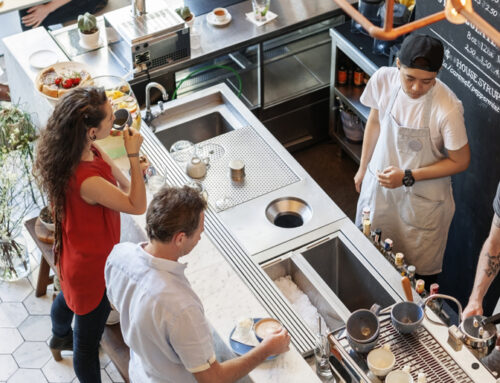When it comes to running a foodservice business, there are numerous operational aspects beyond serving high-quality coffee and food that contribute to your success. From rent and utilities to food and labor costs, restaurant, cafe, and coffee shop owners know all too well that basic operating expenses can stack up quickly. Therefore, they must find creative ways to protect their bottom line.
Below are effective cost management techniques your business can implement into your daily foodservice processes to offset rising operating expenses.
1. Control Your Food Inventory and Waste
Any leftover food scraps, beverages, and plastic waste you accumulate throughout the day could be costing your business more than you think. Consistently tossing out large amounts of waste may be an indicator that you are serving your customers more than they need. Portion control is a simple, yet highly effective way to help you reduce costs, prolong the life of your inventory, and also leave a greener footprint as you cut back your waste-to-landfill.
In addition to controlling portions, you can further manage food inventory and waste by sitting down to critically review your menu to determine which low-profit items can be cut or which recipes can be adjusted to include fewer ingredients. Developing a smart stock budget that focuses on your most profitable items will help you boost your ROI so you can meet changing consumer demands in the future.
2. Prioritize Training to Improve Staff Retention
When you focus on providing your staff with the best training and support, you empower them to provide a higher level of service that keep customers coming back. Furthermore, the better your staff understands their contribution to your bottom line, the more attentive they will be to crafting high-quality coffee and food menu offerings.
A great foodservice training program has the potential to not only help you maintain your operation costs but significantly improve your stream of revenue. Prioritizing in-depth equipment and customer service training that fosters growth and shows employees that you are invested in their success can help you reduce employee turnover. This in turn will help you, as the owner, reduce the cost of time and resources spent on recruiting and training new hires.
Once you have established a consistent training program, you can take your employee success even further by implementing a VoC (Voice of Customer) program to give your team an incentive to be more efficient. This will also allow you to see where in your current operations customers are seeing weak points so that you can tailor your training to address them.
3. Lower Your Energy & Water Bills
Most essential coffee and cooking equipment requires energy and/or water to function. Luckily, many foodservice and coffee equipment manufacturers are focused on making their products more eco-friendly. By investing in equipment that includes modern energy-efficient and low-flow features, you can reduce your energy and water consumption in the long run without sacrificing the quality and quantity of your service.
There are several other quick and easy ways that you can alter your energy and water usage that won’t negatively affect the flow of your daily operations:
- Install low-flow faucets in your kitchen and restrooms to reduce water flow.
- Install automatic lights that turn off when no one is present. Furthermore, ensure you are using energy-efficient bulbs.
- Take advantage of good weather conditions and turn off your A/C. You can open windows to provide airflow if needed.
- If you are opting to use reusable dishes to cut back on waste, only run the dishwasher when it is full to cut back on water, soap, and energy costs.
- If you do not want to purchase any new equipment for this endeavor, you should go through your restaurant, coffee shop, or cafe daily to unplug any low to no use appliances.
4. Explore The Value of Your Vendors
With inflation at an all-time high across all industries, most vendors understand the need to create a strict budget and are willing to work with you to find solutions that prioritize your success. In fact, many have programs in place that go beyond just providing high-quality products. A great foodservice partner will be able to provide you with business insights, equipment advice, training resources, and support that helps you improve your bottom line.
It is a good practice to sit down with your vendor representative to examine where every part of your business’ budget is going (shipping costs, equipment maintenance, technology, etc.). With this knowledge, you can determine what resources are necessary to increase your revenue and which do not contribute as much to your operation costs.
Key Takeaways
While cutting costs with some of the above techniques may seem overwhelming at first, these measures can still ensure you can continue offering the best foodservice experiences possible without altering the quality and prices of your services.
Contact us today to learn how you can find the right coffee program, training services, and equipment solutions to help you your business in the long run.







